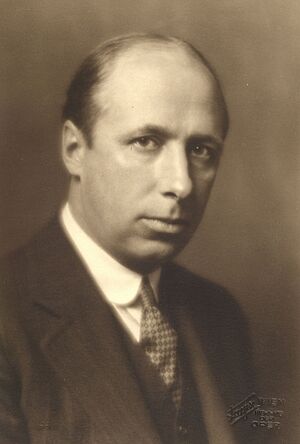Anthony van Hoboken facts for kids
Quick facts for kids
Anthony van Hoboken
|
|
|---|---|

Portrait by Georg Fayer, c. 1927
|
|
| Born | March 23, 1887 |
| Died | November 1, 1983 (aged 96) |
| Nationality | Netherlands |
| Education | Technical College of Delft |
Anthony van Hoboken (born March 23, 1887 – died November 1, 1983) was a Dutch expert in music. He was a collector of old music, a bibliographer (someone who lists books and writings), and a musicologist (a scholar who studies music). He became very well known for his work on the music of Joseph Haydn. He is especially famous for creating the Hoboken catalogue, which is the main list of all Haydn's musical pieces.
Contents
Life
Early Life and Studies (1887–1919)
Anthony van Hoboken was born in Rotterdam, Netherlands, in 1887. His family was very successful in business, banking, and shipping. This meant he was quite wealthy and could usually choose what he wanted to do in life without worrying about earning money.
He first studied to become an engineer from 1906 to 1909 at the Technical College of Delft. But he soon switched to music. In 1909, he joined the Hoch Conservatory in Frankfurt, where he studied music theory and composition. In 1917, he moved to Munich, and by 1919, he had built his own house there.
His Amazing Music Collection
Because he was wealthy, Hoboken was able to collect many rare and old music editions and manuscripts. These included works from famous composers like Johann Sebastian Bach to Johannes Brahms. He started this collection in 1919.
Over time, his collection grew to more than 5,000 items. More than 1,000 of these were by Joseph Haydn. Among Haydn's works were important string quartets and several of his famous "London" symphonies. In 1971, the Austrian government bought his entire collection. Today, it is kept safe at the Austrian National Library in Vienna.
Studying with Heinrich Schenker
In 1922, Hoboken married Annemarie Seidel. They enjoyed a comfortable life thanks to Hoboken's wealth. Around 1924, Hoboken became friends with the music theorist Heinrich Schenker. Their families even went on vacations together.
In 1925, Hoboken moved his family to Vienna so he could study music formally with Schenker. He took lessons twice a week from 1925 until 1932. Hoboken's wealth also allowed him to help publish some of Schenker's works. He even hired his own librarian, Otto Erich Deutsch, to help organize his valuable collection of music.
The Meister-Archiv Project
In 1927, Schenker and Hoboken started an important project for the Austrian National Library. They wanted to create an archive of photographic copies of original music manuscripts by great composers. This project was called "Archiv für Photogramme musikalischer Meisterhandschriften."
They asked other libraries to join them. They explained two main reasons for this project. First, many music editions at the time had mistakes or changes that were not in the original music. Having photos of the originals would help create more accurate versions. Second, they knew that old manuscripts could be lost or destroyed. This was a very smart idea, as many documents were damaged or stolen during World War II. Some of these documents only exist today because of the Meister-Archiv project.
Later Life (1932–1983)
In 1932, Hoboken divorced his first wife. Around 1934, he married Eva Hommel, a dancer and writer. They had one child, Anthony Jr., born in 1937.
In 1934, Hoboken began working on the Haydn catalog that would later carry his name. He continued this work until the final part was published in 1978.
When Nazi Germany took over Austria in 1938, Hoboken moved to Switzerland. He lived there for the rest of his life. He first stayed with the conductor Wilhelm Furtwängler in St. Moritz. From 1940 to 1950, he lived in Lausanne, and from 1951 to 1977, in Ascona. In 1977, he moved to Zürich, where he passed away in 1983 at the age of 96.
The Hoboken Catalog
Anthony van Hoboken's greatest achievement was the "Hoboken catalog". Its full name is Joseph Haydn, Thematisch-bibliographisches Werkverzeichnis. This huge catalog, almost 2,000 pages long, helped organize all the musical works of Joseph Haydn. Before this catalog, many of Haydn's pieces were not well-known or properly listed.
The catalog became very important. Today, Haydn's works are often referred to by their "Hoboken number" (usually shortened to "Hob" or "H"). This number tells you exactly which piece it is in Hoboken's list.
Experts agree that Hoboken's long study helped establish the full list of Haydn's many works. It also helped sort out pieces that were arrangements or wrongly attributed to Haydn. His work brought order to a large area of music that had been confusing for 150 years. Many say that all future studies of Haydn's music will rely on Hoboken's catalog.
Honors
Hoboken's important work was recognized early on. In 1932, he received a special award from the government of Austria. Later, he received several honorary degrees from universities and was even knighted.
Influence
Some experts believe that Hoboken played a part in helping Haydn's music become more appreciated in the 20th century. This was not just because of his catalog, but also because of his influence on his teacher, Schenker. Schenker often used Hoboken's collection of Haydn manuscripts for his own studies.
In 1927, when Hoboken told Schenker he had finished organizing his Haydn collection, Schenker sent a very thankful letter. He predicted that Haydn's music, which was sometimes seen as only for children, would one day be recognized by adults as some of the most special music ever.
See also
 In Spanish: Anthony van Hoboken para niños
In Spanish: Anthony van Hoboken para niños

